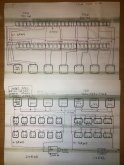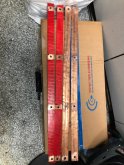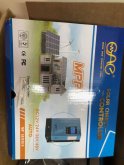Your wiring layout looks good, but that was the easy part

Now you need to start thinking of the actual hardware to do all this, your actual connections, combiners, fusing/breakers and disconnects.
I'd recommend you take a very hard look at your mppt input limits, not just voltage but the allowable amperage and keep it under 80% of the units capabilities for longevity. In general you dont want to be routinely driving things over the 80% mark for voltage or amperage.
Then start at one panel group and on very large sheets of paper draw out in gnats-ass detail EXACTLY how the power is produced, combined, overcurrent protection for the high voltage wires, their disconnects, the input into the MPPT, the output, the output disconnect, the battery, the battery output to inverter, it's disconnect and overcurrent protection, input to the inverter. Draw out every wire, every connector, every fuse or breaker, the boxes things go in, the things those boxes need (grommets, strain relief, etc). How about cooling for the equipment? How to keep out bugs, dust, water and curious small fingers. What tools will you need?
Then duplicate that for however as many panel groups you have. This'll tell you how much and what hardware you'll need to take with you. Then add 25%. Remember, no solar mart down the road, and the stuff you can find locally may or may not work with the stuff you bring and you'll need to know that too.
There's enough power in a battery bank to cook a rhino, how are you going to keep from killing curious morons because there always at least 1 in the area.
I think that once you start detail-level planning you'll change your mind a dozen times or more about what and how you want to accomplish.
I see you've got 14A coming out of your top left set of panels, is that a series/parallel arrangement? If not those are some big horking panels then. I think the biggest Ive seen is 12A, if they are going to be parallel how are you going to parallel them? In a combiner box or a T adapter, will there be fuses at the panels in MC4 fuseholders?
Lots of stuff to think about and hours and hours on google/amazon/etc on figuring out how to actually pull off your plan.
Also, unless you're dropping money on top quality Morningstar, Midnite, Outback, Magnum gear expect a 10% failure rate on complex electronics and have a plan on how to deal with it. Electronics like this either fail within a couple weeks, or last for a long time as long as it's not being abused.
You will need to leave them with a spares package and educate somebody there how to maintain it.
You can do this, its just a matter of breaking the problem down to very small chunks and stepping/solving your way through it. Then
DOCUMENT your plan as you go through it.
Trust me you're just not going to be able to remember the sheer mass of details you end up with, and with a well documented plan you can hand it off to others and they'll understand what you're doing and how without you having to be in 3 dozen places at once during the install.
Good luck!





